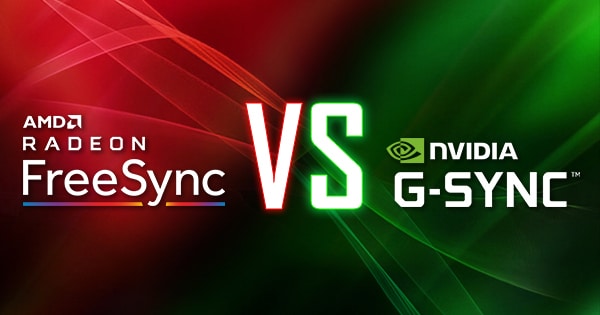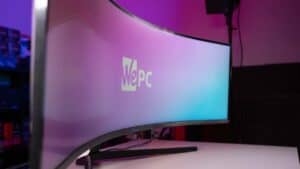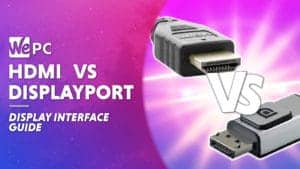FreeSync vs G-Sync – which monitor is better for gaming?
We are here to help you decide which you should buy.

WePC is reader-supported. When you buy through links on our site, we may earn an affiliate commission. Prices subject to change. Learn more
If you’re into gaming, then chances are that you’re familiar with the terms ‘G-Sync’ and ‘FreeSync.’ These are adaptive sync technologies developed by NVIDIA and AMD, respectively. Both perform similar functions – they help eliminate screen tearing and stuttering to deliver a smoother gaming experience.
Now, even though their primary function is the same, the technologies themselves are slightly different. Also, you will notice a difference in prices, with G-Sync monitors being a bit more expensive than the FreeSync ones.
Choosing between FreeSync and G-Sync monitors may not sound like a difficult decision. But it might make a difference to gamers who do not want to compromise on performance or want the absolute best tech in their arsenal. To help you make an informed decision, we have put together a brief guide. Read on to learn more about FreeSync and G-Sync, how the tech works, the main differences, and top monitors.
NVIDIA G-Sync – what is it, and how does it work?
As mentioned above, both technologies tackle screen tearing in games, but they are implemented rather differently. Nvidia’s G-Sync monitors use a proprietary scaler that is limited to two inputs, DisplayPort and HDMI, with only DisplayPort supporting the adaptive sync technology. A scaler is a piece of hardware that is installed during the manufacturing process, increasing the average cost of G-Sync monitors quite significantly when compared to the cheaper Freesync alternatives.
Check out our comprehensive guide to G-sync vs G-sync compatible.
AMD FreeSync – what is it, and how does it work?
Freesync is AMD’s open standard, not requiring any hardware implementation during the manufacturing process, keeping costs down. Freesync monitors offer more connectivity options, which include older outputs like DVI or VGA and newer HDMI.
At first, G-Sync would only work with supported Nvidia graphics cards. However, Nvidia changed this in the last few years to allow G-Sync modules to support AMD graphics cards, too. Just like G-Sync, Freesync used to only be compatible with an AMD card; however, just like G-Sync, some Freesync monitors now support Nvidia graphics cards.
FreeSync vs G-Sync – what’s the difference?
Before we get into an elaborate discussion about the differences between FreeSync and G-Sync, let’s compare the two briefly –
| FreeSync | G-Sync |
| AMD’s tech | NVIDIA’s tech |
| Uses adaptive sync protocol | Uses a dedicated G-Sync module |
| Potential inconsistencies due to monitor – GPU combination | Consistent performance due to direct connection with G-Sync module |
| Fewer extra features | Extra features like ULMB |
| Usually affordable | Slightly pricier than FreeSync |
Both are extremely similar, and you may be leaning towards Freesync due to the lower cost of the supporting monitors. Despite this, the G-Sync certification program ensures that all compatible monitors also have support for LFC (low framerate compensation). LFC will ensure that the variable refresh rate will still work when it dips below the adaptive sync refresh rate.
This was mentioned before, but let’s go over it again: when your display has an adaptive sync window of between 60 to 120Hz, it can still suffer from screen tearing when it dips below 60 or goes above 120. LFC in Nvidia’s G-Sync prevents this from happening and is the main benefit of paying more for one of these monitors.
G-Sync works on GeForce 600 series graphics cards or newer, whereas Freesync works on Radeon RX 200 series or newer. Don’t worry if you have a GeForce card and a Freesync monitor or vice versa; it will still work, but you won’t be able to take advantage of the adaptive sync technology unless that particular model is confirmed to be “compatible” with both.
Freesync 2 Vs. G-Sync Ultimate
The latest iterations of AMD and Nvidia’s screen tearing solutions, with LFC being introduced into Freesync 2 and HDR support into G-sync ultimate. Freesync 2 doesn’t replace the older tech; it’s validated to a higher standard, meaning Freesync 2 offers more “premium” features.
HDR monitors have been growing in the market, and so naturally, AMD’s Freesync 2 now supports HDR. Along with HDR support, we see the same LFC technology we saw with the G-Sync modules being implemented. Low latency and high contrast requirements have been added, basically bringing the technology up to the G-Sync level.
G-Sync Ultimate is much the same as Freesync 2, yet it is much more reliable, more expensive, and features dedicated hardware rather than Being software enabled. Basically, G-Sync Ultimate features the latest Nvidia processor and will deliver over 1000 nits brightness, along with excellent contrast and cinematic colors, ultimately bringing you the best gaming experience possible.
Frequently Asked Questions
Here are some FAQs –
Can I use FreeSync with Nvidia?
Yes, as mentioned in the article above, you can use a FreeSync monitor with an NVIDIA graphics card. Post 2019, NVIDIA introduced G-Sync compatibility, which allows users to use FreeSync monitors with NVIDIA GPUs. However, we would recommend double-checking compatibility as not ALL FreeSync monitors work with NVIDIA.
Why is G-Sync more expensive than FreeSync?
There are two major reasons why G-Sync monitors cost a bit more than their FreeSync counterparts. To start with, NVIDIA G-Sync uses a dedicated hardware module, which is installed on the monitors. These modules communicate directly with NVIDIA’s graphics card, which helps maintain a smooth gaming performance. Further, NVIDIA charges license fees from manufacturers who use G-Sync, which adds to the final cost of the product.
Conclusion
G-Sync is undoubtedly the better adaptive sync technology, but with the price of these monitors being so high, you are going to need to ensure your PC can run these games in all their glory to make it worth it. Alternatively, Freesync offers a cheaper alternative that gives a lot of people excellent gameplay for a fraction of the cost.
While G-sync is better, the decision boils down to your individual needs – money is no object. Get a G-Sync Ultimate monitor, you won’t have experienced smooth 4K gameplay like it ever before. For those who have an aging system or a strict budget but still want to eliminate screen tearing, Freesync is the likely way to go.
Have you invested in a G-Sync or Freesync monitor? How noticeable of a difference was the upgrade? Which adaptive sync technology works best for you? Head over to the WePC Community and share with the ever-growing gang of enthusiasts.











